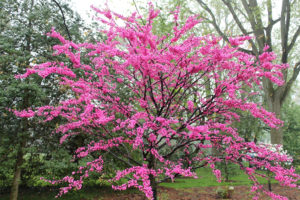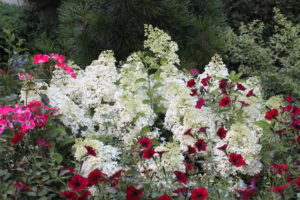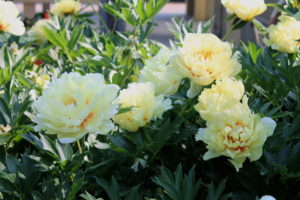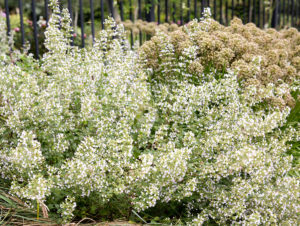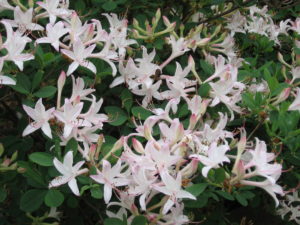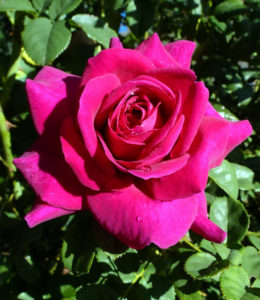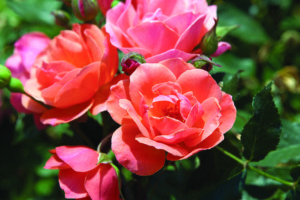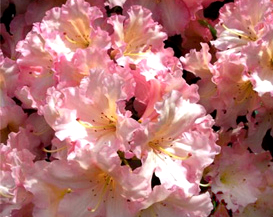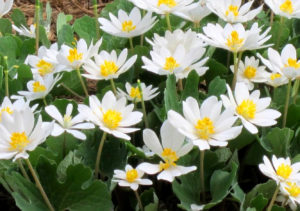Award-Winning Plants of 2021
March 16th, 2021
So many plants to pick from… but which ones are the best?
One bit of homework to go on is plants that have won awards from various plant-trial and plant-selection programs.
Each year, organizations of growers, horticulturists, researchers, and other plant experts bestow awards on top plant performers – some new, some old but just under-used.
Here’s a look at plants that have won honors for 2021:
A panel of experts assembled by the Pennsylvania Horticultural Society (best known for running the Philadelphia Flower Show) each year picks trees, shrubs, and perennials worthy of greater use in Pennsylvania landscapes.
For 2021, seven plants made the Gold Medal grade.
Redbud ‘Appalachian Red’
The vibrant deep-pink blooms really jump out when this small native tree flowers in early spring, even before the leaves emerge.
Like all redbuds, ‘Appalachian Red’ does best as an under-story tree in “woodsy” well drained soil out of direct afternoon sun. It grows about 20 feet tall and wide in 20-25 years.
London plane tree Exclamation! (‘Morton Circle’)
This is a cultivar of a large shade tree similar to sycamore – big leaves and bark that peels over time to reveal a white, smooth skin.
Exclamation! is a fast-grower that can reach 55 to 65 feet tall and 40 to 50 feet wide and is tolerant of and resistant to most abuses. Best in full sun.
Dwarf panicle hydrangea Bobo
Many compact and heavier-blooming versions of the old-fashioned “PeeGee” hydrangea have come along in recent years, and this is one of the showiest.
Bobo produces large, cone-shaped, white flowers in July that take on shades of pink and then rust as the season progresses. Plants grow a stocky four to five feet tall and wide in full sun or light shade.
Sweet box ‘Fragrant Valley’
Little known even though it’s one of the most fragrant landscape plants on the market, this plant is a glossy, broad-leafed evergreen with a somewhat boxwood-like appearance and a trailing habit.
The small white flowers come out in early spring. ‘Fragrant Valley’ is a particularly sweet-smelling variety. It grows about 18 inches tall and spreads three to four feet, ideally in shade.
Dixie woodfern
One of the three 2021 perennial-plant winners is this four-foot-tall green fern that’s native to the southeastern United States.
It’s a clumping fern with glossy leaves and an upright habit. It’s deer-resistant and grows best in shade or at least out of afternoon sun.
Peony ‘Bartzella’
‘Bartzella’ is arguably the best of the Itoh hybrid peonies, which are a stately and long-blooming cross of herbaceous and tree-type peonies.
This one has fist-sized blooms of soft yellow with a pinkish-red throat, and like most of the Itoh peonies, has strong, flop-proof stems to hold the big flowers more upright. It grows about three feet tall and wide in full sun and blooms primarily in June.
Rudbeckia ‘American Gold Rush’
This new and heavy-blooming introduction could become the standard for black-eyed susans, that native perennial that blooms in summer with golden petals around a black central cone.
‘American Gold Rush’ not only blooms brilliantly and heavily, but it’s resistant to the septoria leaf-spot disease that’s been plaguing other black-eyed susans lately. It grows two feet tall, ideally in full sun.
(Disclosure: George is a member of the Gold Medal panel.)
Members of the Perennial Plant Association vote to honor one perennial plant each year that’s superior in terms of performance, low care, pest resistance and multiple-season interest. The 2021 winner is…
Calamintha
This sun-loving, drought-tough, mint-family creeper is nearly covered with clouds of tiny white flowers from early summer to fall. Although it’s not a U.S. native, bees and pollinators like it but deer don’t.
Sometimes nicknamed “lesser catmint,” calamintha grows about 18 inches tall and is best used in rock gardens, sunny borders, or as a groundcover on sunny slopes.
This program, run by the staff and Horticulture Committee at Jenkins Arboretum and Gardens in Devon, Pa., focuses on singling out some of our region’s best native plants for home landscapes.
Three plants won 2021 Green Ribbon awards:
Aromatic aster (Symphyotrichum oblongifolium)
This late-season perennial is a pollinator magnet that produces blue-purple, daisy-like flowers with yellow centers in August and September.
It grows three feet tall, spreads to form a dense colony, and grows best in full sun.
Coastal azalea (Rhododendron atlanticum)
Native moist, acidic coastal areas from Pennsylvania south to Georgia, this deciduous (leaf-dropping) shrub produces mildly fragrant, pollinator-attracting tubular flowers of pink-tinged white in spring.
It typically grows about three feet tall and four feet across. In home gardens, give it a damp spot out of direct afternoon sun for best performance.
Wild ginger (Asarum canadense)
Sometimes called hardy ginger, this plant is a shade-preferring groundcover with heart-shaped green leaves that spread to make a dense, velvety-green mat only about six inches high.
Wild ginger does best in damp shade and produces small, mostly hidden purple flowers in spring that the native pipevine swallowtail butterfly and several other pollinators like.
Garden Club of America Plant of the Year
This award is bestowed by the national organization of garden clubs, which appoints a plant-expert panel to name one outstanding U.S.-native plant worthy of the Montine McDaniel Freeman Medal. The 2021 medal-winner:
Buttonbush (Cephalanthus occidentalis)
Native throughout the Eastern U.S., this shrub is another pollinator magnet with its little white flower balls that have little “rays” emanating from all around them.
The plant is a food source for dozens of species of birds, butterflies, moths, and bees and is tolerant of damp soils. It grows six to eight feet tall and five to six feet wide in full sun or part shade.
Independent researchers each year evaluate hundreds of new flowers and vegetables in dozens of trial gardens throughout the United States. The highest scorers get All-America Selections awards in a program that dates to 1932.
Two new flowers and one new vegetable were good enough to win 2021 national or Northeast regional AAS honors.
Celosia Kelos Candela Pink
One AAS judge compared this pink-plumed annual to the “Energizer Bunny” for its flowers that just kept coming and coming all season.
Kelos Candela Pink grows about 30 inches tall – ideally in full sun to light shade – and makes an excellent cut or dried flower as well as a showy landscape annual.
Zinnia Profusion Red Yellow Bicolor
This new zinnia in the compact, disease-resistant Profusion series was good enough to earn a 2021 AAS, best-of-the-best Gold Medal.
Judges liked the color-changing attribute of this one – flowers that start golden-yellow with a vibrant red center, then morph into softer shades of apricot, salmon, and dusty rose.
Profusion Red Yellow Bicolor grows about a foot tall and flowers best in full sun.
Squash ‘Goldilocks’
This small-fruited new acorn squash is vigorous and mildew-resistant in growth and high in yield, producing an average of 10 or more four-inch fruits per plant.
The sweet, nutty-flavored fruits mature to orange 85 days after the seeds are direct-sown. The vining plants grow about 30 inches tall and five feet across, ideally in full sun.
American Garden Rose Selections
This program of the rose industry and American Rose Society evaluates roses at 12 different trial gardens in six U.S. geographical regions, looking for superior performance in vigor, habit, flower power, reblooming ability, fragrance, cold-hardiness, and more.
Four roses earned AGRS awards in the Northeast region for 2021:
Brick House
This Star Roses and Plants introduction is a dark-red-blooming floribunda type with good disease resistance, good drought resistance, and strong reblooming tendencies. The flowers are small but plentiful on 3½-foot-tall bushes.
Brindabella Purple Prince
A shrub rose with hybrid-tea good looks, Brindabella Purple Prince has fragrant, double red-purple flowers on a four-foot bush. It also has excellent disease resistance. From Suntory Flowers in partnership with the Dig Plant Co.
Easy to Please
This one is a pink-blooming, upright floribunda with very good disease resistance and a moderate clove fragrance. Introduced by Weeks Roses.
Sweet Spirit
Sweet Spirit won both a Northeast Regional Award and an AGRS Fragrance Award for its strong, sweet scent. It’s a grandiflora type with double cherry-red blooms on a bushy, three- to four-foot plant. Introduced by Star Roses and Plants, it also does particularly well in hot, humid climates.
American Rose Trials for Sustainability
A.R.T.S. is a rose-evaluation program that aims to identify the regionally best roses in eight different U.S. climate regions.
No-spray evaluations at 19 botanic-garden, university, and park trial sites look at bug and disease resistance, drought tolerance, beauty, vigor, and more over two years. Ones that out-perform the comparison industry standards win “Local Artist” awards.
Four roses – all shrub types – scored well enough to earn 2021 Local Artist honors in our region.
Coral Knock Out
One of the top-selling Knock Out clan, this one grows in a mounded form and produces clusters of warm, peachy-orange blooms. New foliage is red. Introduced by Star Roses and Plants.
Easy Elegance Chi
Easy Elegance Chi has small but plentiful burgundy-red double blooms on a dense bush with dark-green, semi-glossy foliage. From Bailey Nurseries.
Flower Carpet Pink Supreme
This double hot-pink member of the popular Flower Carpet series has a spreading habit, glossy foliage, and does especially well in humidity. From Anthony Tesselaar Plants.
Oso Easy Double Pink
Clusters of double, medium-pink blooms cover this low-growing spreader, which makes an ideal colorful, front-of-border groundcover. Introduced by Spring Meadow Nursery.
Members of the American Rhododendron Society each year select top-performing rhododendrons and azaleas in eight different U.S. regions.
Four winners were named for 2021 in the Mid-Atlantic region, which includes much of Pennsylvania. Ideal light is morning sun and afternoon shade.
Large-leaf rhododendron: ‘Jack Cowles’
This upright May bloomer grows about four feet tall in 10 years and has yellow-tinted pink flowers. It’s a heavy bloomer with wavy-edged leaves.
Small-leaf rhododendron: ‘Weston’s Pink Diamond’
An early bloomer, the flowers on this variety are semi-double, ruffled, and purplish-pink in color. It grows upright to about five feet tall in 10 years.
Evergreen azalea: ‘Betty Ellen’
The flowers on this rounded evergreen are purplish-pink in bud, opening white with light purplish-pink margins. It blooms in May and grows about three feet tall and slighter wider in 10 years.
Deciduous azalea: Rhododendron austrinum
Nicknamed the “flame azalea,” this one’s a Southeastern-U.S. native azalea that flowers in April in shades of yellow, gold, and orange. It’s also very fragrant and both cold-hardy and heat-tolerant. It typically grows six to eight feet tall and four to five feet wide.
Members of the America Hosta Growers Association each year vote on a favorite hosta variety that must be a superior performer nationwide. This year’s winner:
‘Rainbow’s End’
The 2021 Hosta of the Year is a glossy, heavily variegated variety with bright-yellow and dark-green striped patterning. The center changes to creamy white in summer.
The flowers of ‘Rainbow’s End’ are lavender, and the stems are red. Plants grow about a foot tall with the blooms poking up another six to eight inches in mid-summer.
Herb Society Notable Native Herb
Every year, the Herb Society of America’s Native Herb Conservation Committee selects one or more native plants that deserve more use in American gardens. The selections are called Notable Native Herbs (although not all are herbs).
For 2021, a tree and a perennial won Notable honors:
Bloodroot (Sanguinaria canadensis)
Native throughout the Eastern U.S., bloodroot produces short-lived, white, daisy-like flowers on six- to 10-inch plants in early spring. It gets its name from the red sap in its roots, which native Americans used for dye.
Honeylocust (Gleditsia triacanthos)
Honeylocust is a central-U.S. native tree with small, opposite leaves and an open, airy habit. It grows 60 to 80 feet tall and turns yellow in fall. Thornless and seedless varieties are typically planted as opposed to the thorny, seed-pod-filled straight species.








